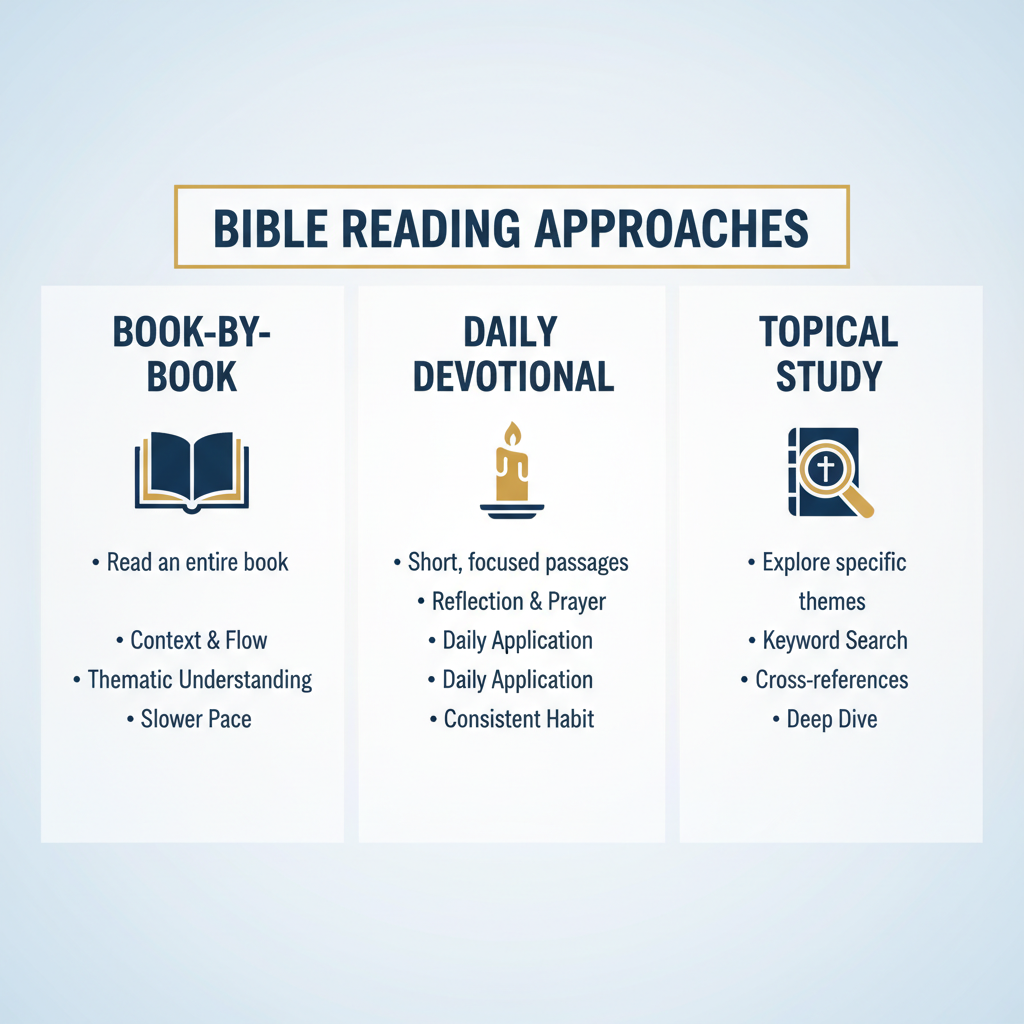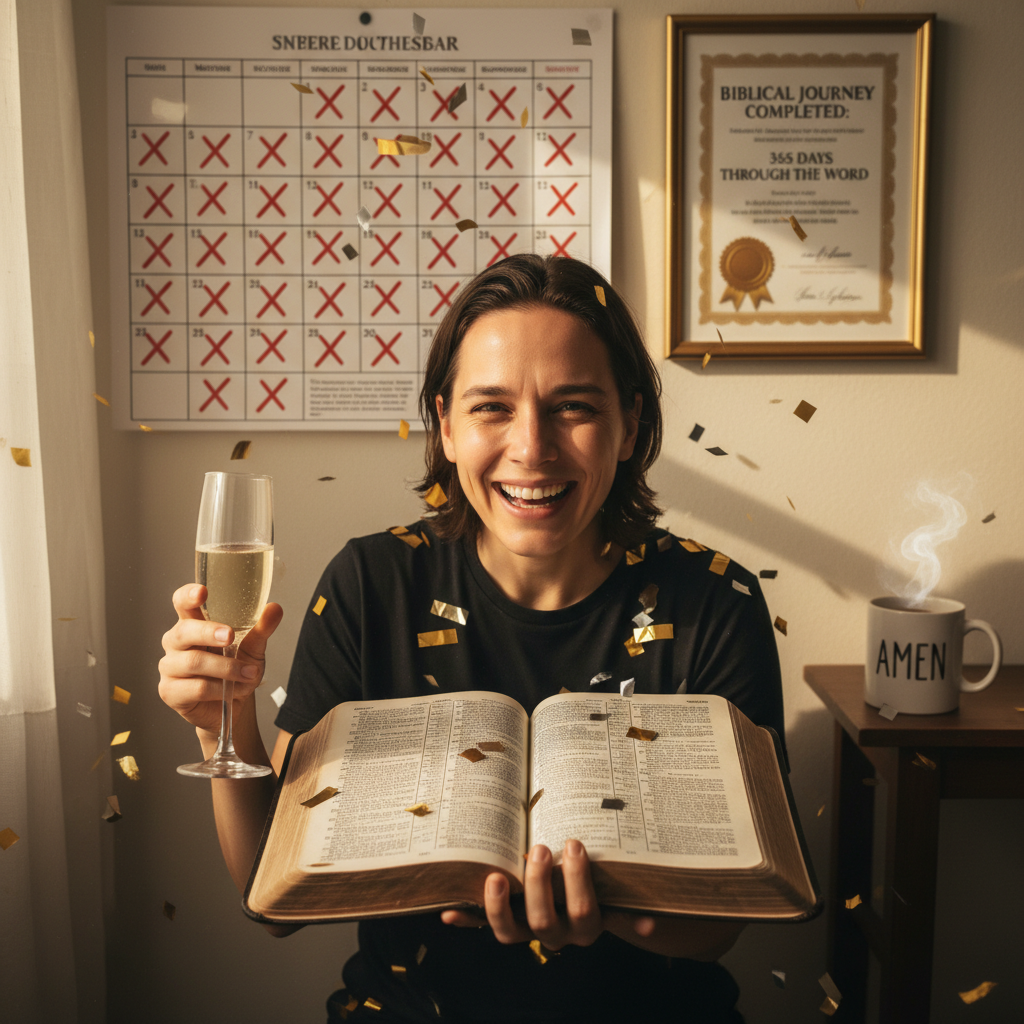Every January 1st, millions of people around the world open their Bibles to Genesis 1:1 with the same resolution: "This is the year I'll actually read the whole thing." They make it through Creation. They survive the Flood. Some even push through Abraham's wanderings and Joseph's coat of many colors.
Then they hit Leviticus.
The book opens with detailed instructions about burnt offerings, grain offerings, fellowship offerings, sin offerings, and guilt offerings. There are measurements. There are blood rituals. There are precise specifications about which animal parts go where. By Leviticus 7, most people's eyes glaze over. By Leviticus 15, many have quietly abandoned their plan, bookmark gathering dust somewhere in the detailed laws about skin diseases.
But here's what's fascinating: those who push through Leviticus, who make it to the narrative payoff of Numbers and Deuteronomy, who discover the epic conquest stories in Joshua, who fall in love with Ruth and weep over David - they often say the same thing. "I can't believe I waited this long to read the whole story."
Because the Bible isn't a collection of disconnected inspirational quotes. It's a story. And like any great story, you miss enormous chunks of meaning when you only know the famous parts.

The Presbyterian Minister Who Changed Everything
The year was 1842. In the industrial city of Dundee, Scotland, a twenty-nine-year-old Presbyterian minister named Robert Murray M'Cheyne faced a problem. His congregation wanted to read Scripture systematically, but most of them worked grueling twelve-hour days in the textile mills and jute factories that defined the city's economy. They were tired. They were barely literate in many cases. And the idea of reading straight through the Bible felt overwhelming.
M'Cheyne, who would die of typhus just four years later at age 29, created something revolutionary: a structured plan that would take readers through the entire Bible in one year, but with daily variety to prevent burnout. His genius was the balance. Instead of slogging through Leviticus for weeks, readers would tackle a chapter or two of Leviticus alongside passages from the Gospels, a Psalm for worship, and verses from Proverbs for practical wisdom.
The M'Cheyne Reading Plan, as it came to be called, was actually even more ambitious than modern plans. It took readers through the Old Testament once and the New Testament and Psalms twice in a single year. Factory workers who could barely read were suddenly engaging with Ezekiel and Revelation. Children were memorizing Psalms. The plan spread like wildfire through Scottish Presbyterian churches, then jumped to England, crossed the Atlantic to America, and eventually became the template for nearly every one-year Bible reading plan in existence.
What M'Cheyne understood - what modern neuroscience has now confirmed - is that variety sustains motivation. When you alternate between narrative history, prophetic poetry, practical wisdom, and gospel accounts, your brain stays engaged. You don't get bogged down. And critically, you see connections that pure sequential reading obscures.
Reading about the Passover lamb in Exodus while simultaneously reading about Jesus as "the Lamb of God" in John isn't coincidence. It's the entire point. The Bible is one unified story of God's redemption, and M'Cheyne's structure - which modern plans still follow - ensures you experience that unity daily.

Why 365 Days? The Science of Temporal Landmarks
Behavioral economists have a term for the psychological phenomenon that makes January 1st feel like the perfect time to start a Bible reading plan: the "fresh start effect." But here's what most people don't know - the research shows that any temporal landmark works just as well. Your birthday. The first day of spring. Even Monday morning.
A landmark 2014 study by Wharton professor Katy Milkman and her colleagues found that people are significantly more likely to pursue goal-directed behavior after temporal landmarks - dates that stand out from the ordinary flow of time. New Year's is the most obvious landmark, which is why Bible reading searches spike 500% in the first week of January. But the research found that personal landmarks (birthdays, anniversaries, the start of a new season) trigger the same psychological mechanism.
The mechanism is this: temporal landmarks allow us to mentally categorize our past imperfect self as belonging to a previous era. "Old me" didn't finish the Bible. But "new me" - the me starting fresh on this landmark date - will be different. The slate feels wiped clean. The failure belongs to someone else.
This has profound implications for Bible reading plans. The traditional advice - "start January 1st" - isn't wrong, but it's not the only option. If you're reading this in June and thinking "I should wait until next January," you're missing the point. Today can be your temporal landmark. Your decision to start today makes it a landmark.
But why specifically one year? Why not six months, or eighteen months, or read at your own pace with no deadline?
The answer lies in what psychologists call "optimal challenge." A goal that's too easy (read the Bible in five years) generates little motivation. A goal that's too hard (read the Bible in thirty days) generates anxiety and quick failure. One year sits in the sweet spot - ambitious enough to feel meaningful, achievable enough to feel possible.
More importantly, 365 days takes you through an entire cycle of seasons, holidays, work pressures, and life circumstances. You'll read Scripture in winter darkness and summer sunshine. During stressful seasons and peaceful ones. Through grief and celebration. The year-long timeframe ensures that God's Word intersects with the full spectrum of human experience, not just a single snapshot.
And here's the neuroscience angle: habit formation research suggests it takes about sixty-six days for a new behavior to become automatic. That's the median from a 2009 University College London study. But one year - 365 days - provides five and a half cycles of that duration. By the time you reach December, daily Bible reading isn't a discipline you're white-knuckling through. It's simply what you do. The habit is encoded in your neural circuitry.
The Brutal Truth About Completion Rates
Here's a statistic that will either discourage or motivate you: only about 8-9% of people who start a one-year Bible reading plan actually finish.
The data comes from multiple sources - surveys by LifeWay Research, informal polls by Bible Gateway and YouVersion, and completion tracking from various reading plan apps. The numbers vary slightly depending on methodology, but they cluster around the same sobering range. Roughly nine out of ten people who resolve to read the Bible in a year will abandon the effort before they reach Revelation 22.
Where do people drop off? The data shows three critical danger zones. The first is Leviticus through Numbers - roughly weeks 4-8 for most plans. This is the "valley of detailed regulations" that claims many earnest readers. The second danger zone is around month six, when the initial motivation has worn off but the finish line still feels distant. The third cliff comes in November and December, when holiday chaos disrupts established routines.
But here's where the research gets interesting: completion rates skyrocket when people read in groups rather than alone. Studies of church-based reading plans show completion rates of 65% or higher when participants have regular accountability check-ins, discussion groups, or reading partners. That's a seven-fold increase over solo reading.
What accounts for this dramatic difference? Social psychology research points to several factors. First, public commitment - when you tell others about your goal, you're more likely to follow through because abandoning creates social cost. Second, peer comparison - seeing others' progress motivates you to keep pace. Third, shared struggle - knowing others are also finding Leviticus tedious somehow makes it more bearable. Fourth, celebration of milestones - group environments naturally create moments to acknowledge progress.
The most successful Bible reading communities build in what researchers call "implementation intentions" - specific if-then plans. Not "I'll read daily," but "If I pour my morning coffee, then I open my Bible." Not "I'll try to keep up," but "If I miss two days, then I'll use Sunday afternoon to catch up." These concrete triggers bypass willpower and create automatic behaviors.
And here's something the 91% who quit often don't realize: falling behind isn't failure unless you decide it is. The research on goal abandonment shows that people don't quit because they miss a few days. They quit because they interpret those missed days as evidence they're "not the kind of person who can do this." The narrative they tell themselves - not the actual behavior - determines the outcome. Groups help rewrite that narrative from "I'm failing" to "I'm human, and I'm continuing."

What Happens When You Actually Finish
Jennifer Martinez, a high school English teacher in Austin, Texas, had been a Christian for fifteen years when she decided to read the Bible cover to cover. "I knew all the Sunday School stories," she told me. "I could quote Philippians 4:13 and Jeremiah 29:11. I knew John 3:16 by heart. But I'd never actually read Habakkuk or Zephaniah or 2 Chronicles. I wasn't even sure where those books were."
Her breakthrough came during the Minor Prophets - those twelve short books at the end of the Old Testament that most Christians never read. "I was in Amos, reading about God's judgment on Israel for oppressing the poor and needy, and suddenly I realized - I'd been thinking of God primarily as my personal life coach. Someone who existed to help me feel better and achieve my goals. But here's God absolutely furious about economic injustice and exploitation. The prophets were preaching to comfortable, religious people who said the right words but lived wrong lives. And I thought, oh no. That's me."
This is the pattern you hear again and again from people who complete a one-year plan. They encounter a God bigger and more complex than the one they'd constructed from favorite verses. They discover uncomfortable passages that challenge rather than comfort. They see how much of Scripture addresses topics - justice, wealth, power, community - that modern evangelical Christianity often treats as peripheral.
David Nguyen, a software engineer in Seattle, described a different kind of transformation. "I'm Vietnamese American, second generation, and I grew up in a church where the Old Testament was basically treated as prologue. We did Gospel-heavy teaching. Maybe some Psalms. A few famous stories from Genesis or Daniel. But the assumption was that the real action started with Jesus, and everything before was just setup."
Reading straight through changed that perspective. "When you read all four Gospels while simultaneously going through Isaiah, Jeremiah, Ezekiel - you realize that Jesus is constantly quoting, alluding to, and fulfilling these texts. His first sermon in Luke quotes Isaiah. His entire identity makes no sense without the prophetic tradition. The writers assume you know the Old Testament story. And I didn't. I was missing half the references."
The educational impact is perhaps most dramatic for newer Christians. Pastor Sarah Williams runs a first-year Bible reading group at her church in Nashville specifically for people who became Christians as adults. "We get folks who've never opened a Bible except maybe at hotels. They don't know that Moses comes before David, or that the Gospels aren't in chronological order, or what the difference is between a prophet and a priest. After a year of reading, they have a framework. They understand the story. You can reference 'when the Israelites were in exile' and they know what you're talking about. That literacy is powerful."
But perhaps the most common transformation is simply this: confidence. "Before I read the whole Bible, I always felt like I was missing something," says Robert Chen, a medical resident in Boston. "Someone would reference a passage and I'd nod along, but inside I was thinking, 'I should probably know this.' After finishing the plan, I'm not intimidated anymore. I've been to every corner of Scripture. I know what's in there. I can engage with teaching and preaching as a participant, not just a passive receiver. That shift from consumer to participant - that's been huge."
The Podcast Revolution: Fr. Mike Schmitz and the Bible in a Year Phenomenon
Something remarkable happened in January 2021. A Catholic priest named Mike Schmitz from Duluth, Minnesota, launched a podcast called "The Bible in a Year." The concept was straightforward: Father Mike would read the daily selections from a one-year plan, then spend 20-25 minutes explaining context, highlighting connections, and unpacking theology.
Within weeks, the podcast topped Apple's charts - not just in the religion category, but overall. At its peak, "The Bible in a Year" was the number one podcast in America, beating true crime shows, celebrity interviews, and news programs. By the end of 2021, it had been downloaded more than 150 million times. Millions of people - Catholics, Protestants, Orthodox, and the simply curious - were waking up each morning and listening to Father Mike guide them through Scripture.
What explained the phenomenon? Partly, the pandemic. People stuck at home were searching for meaning, routine, and community. A daily podcast provided all three. But that's not the whole story. Father Mike's approach combined several elements that research shows increase completion rates.
First, parasocial accountability. Listeners felt like Father Mike was reading alongside them - not just providing content but participating in the journey. Second, expert guidance exactly when needed. When listeners hit Leviticus, Father Mike was there explaining why ceremonial law matters and how it points to Jesus. No one had to slog through confused. Third, the combination of reading and listening engaged multiple learning pathways. Fourth, the podcast created a massive virtual community - listeners connected through social media, sharing insights and encouraging each other.
The success of "The Bible in a Year" triggered what you might call the audio Bible boom. Suddenly there were dozens of similar offerings: "The Bible Recap" with Tara-Leigh Cobble, "Pray as You Go" from Jesuit Media, "The Daily Audio Bible" with Brian Hardin (which actually predated Father Mike by years but saw renewed interest), dramatized readings with full casts and sound effects, celebrity-narrated versions, and translation-specific recordings.
This audio revolution solved a critical problem: time scarcity. Reading 15-20 minutes daily requires focused, undistracted time. But listening can happen during commutes, exercise, household chores, or before sleep. The "dead time" in your day - time previously filled with music, news, or podcasts about true crime - becomes Bible engagement time.
There's also neuroscience at play. Reading engages visual processing and linguistic centers. Listening engages auditory processing and, often, emotional centers differently. Hearing Scripture read aloud - especially by a skilled narrator - creates different neural activation patterns than silent reading. Many people report that passages they'd read dozens of times suddenly click when heard rather than seen.
The broader trend points to something important: technology isn't making Bible reading obsolete. It's making it more accessible. Apps track progress automatically. Notifications provide gentle reminders. Audio versions make reading possible during otherwise wasted time. Community features connect isolated readers into virtual reading groups. The core discipline - sustained, sequential engagement with Scripture - remains the same. But the friction has been dramatically reduced.

Canonical, Chronological, or Thematic: Which Path Through Scripture?
Not all one-year Bible reading plans are created equal. The three major approaches - canonical, chronological, and thematic - each offer different advantages and challenges. Understanding the differences can help you choose the plan most likely to keep you engaged for 365 days.
The canonical approach - reading the Bible in the order books appear - is what M'Cheyne pioneered and what most modern plans follow. You progress from Genesis to Malachi in the Old Testament while simultaneously moving through Matthew to Revelation in the New. The genius of this structure is variety. Every day includes historical narrative, theological teaching, worship poetry, and practical wisdom. Your brain doesn't get stuck in a single genre for weeks.
The challenge with canonical reading is that biblical books aren't arranged chronologically. Job probably takes place during the time of the Patriarchs, but it appears after the historical books. Many Psalms reference events from David's life, but you read them long after finishing his story in Samuel. The prophets preached during the period covered by Kings and Chronicles, but they're separated by hundreds of pages. You're constantly jumping backward and forward in historical time.
Chronological plans attempt to solve this by rearranging Scripture into the order events actually occurred. Genesis comes first, as usual. But then you read Job during the patriarchal period. When you reach David's reign in 2 Samuel, you simultaneously read the Psalms he wrote during those years. The prophets slot in exactly when they were preaching - Isaiah during the Assyrian crisis, Jeremiah during Babylon's rise, Ezekiel during the exile.
This historical arrangement creates powerful "ah-ha" moments. Reading Jeremiah's warnings about Jerusalem's destruction right before reading the actual destruction in 2 Kings creates emotional impact that canonical order dilutes. Understanding that Esther takes place during the Persian period between Ezra chapters 6 and 7 illuminates why the Jews were scattered across the empire. Seeing Paul's letters in the order he wrote them, mapped against his journeys in Acts, helps you understand the developing theology.
But chronological reading has its own challenges. When you're deep in the prophets - say, spending weeks in Isaiah, Jeremiah, and Ezekiel because they all ministered during overlapping periods - the reading can feel monotonous. Prophetic literature has a particular style, and too much at once becomes overwhelming. You lose the daily refreshment of alternating genres.
The third major approach - thematic or topical reading - organizes Scripture around subjects rather than sequence. A thematic one-year plan might spend a month on covenant theology, reading every covenant from Noah through the New Covenant. Then a month on worship, collecting Psalms, temple passages, and New Testament teaching about corporate gatherings. Then kingdom theology, women in Scripture, or the character of God.
Thematic plans excel at showing how ideas develop across the entire biblical canon. When you read every passage about prayer in a concentrated period - Hannah's prayer, the Psalms of lament, Solomon's temple dedication, Jesus' teaching on prayer, Paul's instructions about prayer - you develop deep understanding of that topic. The downside is fragmentation. You never get the sustained narrative flow. You're constantly jumping from Exodus to Matthew to Revelation and back to Genesis.
So which approach is best? The honest answer is: whichever one you'll actually complete. For first-time cover-to-cover readers, canonical plans with daily variety usually work best. The mixed content prevents boredom. For second or third readings, chronological order offers fresh perspective and historical clarity. For focused study on specific topics - maybe you're wrestling with questions about suffering, or justice, or the Holy Spirit - thematic reading concentrates relevant passages.
Many successful lifetime Bible readers cycle through different approaches. Year one: canonical for completion and daily variety. Year two: chronological for historical understanding. Year three: thematic deep-dive on areas of confusion or interest. The variety keeps the text fresh even after multiple complete readings.
When You Miss Days: The Theology of Imperfect Obedience
Here's a scenario that plays out thousands of times every January: Someone starts their one-year Bible reading plan with genuine enthusiasm. They nail the first week. Maybe even the first two weeks. Then life happens. A sick kid. A work deadline. A family emergency. They miss a day. Then two days. Then a week. The gap between where they should be and where they are widens. And rather than catching up or adjusting, they quit entirely.
The psychological mechanism here is what researchers call "the what-the-hell effect." Once you've broken your perfect streak, your brain says, "Well, I've already failed, so why bother continuing?" It's the same phenomenon that makes dieters who eat one cookie devour the entire package. The plan was perfect until it wasn't, so now it's worthless.
But this all-or-nothing thinking is theologically backwards. The entire narrative arc of Scripture is about God's faithfulness to people who constantly mess up. Abraham lies about Sarah being his wife - twice. Moses murders a man. David commits adultery and murder. Peter denies Jesus three times. Paul persecuted the church. The Bible is a book about imperfect people encountering a perfect God, not perfect people maintaining perfect records.
The irony of quitting a Bible reading plan because you missed days is that you're abandoning the very text that would tell you God specializes in fresh starts and second chances. Lamentations 3:22-23 says God's mercies are "new every morning" - not "new every January 1st if you maintained a perfect streak."
So what's the alternative? Build grace into the structure from the beginning. The most sustainable one-year plans include catch-up days - blank days with no assigned reading, specifically designed for falling behind. Some plans build in one catch-up day per week (reading only six days, leaving the seventh for overflow). Others include catch-up weeks at quarterly intervals. These aren't "bonus" days for people who are ahead; they're essential infrastructure for normal humans.
Another approach: redefine success. Instead of "I'll read every day without fail," try "I'll read at least 300 days this year." That gives you sixty-five grace days - more than enough for illness, travel, crises, and just being human. You're aiming for consistency, not perfection. Reading 300 days out of 365 is still 82% consistency, which is far better than the 0% you'll achieve if you quit after the first broken streak.
Some readers find it helpful to distinguish between "ideal days" and "minimum viable days." An ideal day includes the full reading, journaling, prayer, and reflection. A minimum viable day is just the reading - maybe even just the New Testament and Psalms portions if you're truly crunched. Permission to have minimum viable days prevents the all-or-nothing spiral. Some Scripture is always better than no Scripture.
Here's another strategy that completion research supports: never miss two days in a row. Miss Monday? That's life. But make Tuesday non-negotiable. The habit research shows that consistency matters more than perfection, and the biggest predictor of habit death is consecutive missed days. One day off is a break. Three days off is a new pattern.
And finally, remember that the goal isn't checking boxes. It's transformation through sustained encounter with God's Word. Whether you finish the Bible in 365 days, 400 days, or 500 days matters infinitely less than whether you actually engage deeply with the text. Better to read the whole Bible thoughtfully in fifteen months than to speed-read in twelve months and retain nothing. Grace yourself. The reading plan serves you; you don't serve the reading plan.

Your Brain on Daily Scripture: The Neuroscience of 365 Days
Neuroscientist Andrew Newberg at Thomas Jefferson University has spent decades studying what happens in the brain during religious practices - prayer, meditation, Scripture reading. Using brain imaging technology, his research team has documented measurable changes in neural activity and even brain structure among people who engage in regular spiritual disciplines.
The findings relevant to Bible reading are striking. When people engage in sustained daily reading of sacred texts - whether Bible, Quran, or other scriptures - several brain regions show increased activity and connectivity. The prefrontal cortex, responsible for focus and attention, strengthens. The temporal lobes, involved in processing language and meaning, show enhanced activation. The limbic system, which governs emotions and memory, becomes more engaged with the material over time.
But here's what's particularly relevant to one-year reading plans: the changes are time-dependent. Occasional Scripture reading produces temporary activation. Daily reading for months creates lasting neural changes. Your brain literally rewires in response to repeated engagement with the text.
The hippocampus - the brain's memory consolidation center - plays a crucial role. When you read Genesis 12 about God's covenant with Abraham, then weeks later encounter references to that covenant in Romans 4, your hippocampus connects the passages. Read the Bible straight through over a year, and your brain builds an extensive network of cross-references and thematic connections that selective reading can't create. You're not just memorizing information; you're building a mental framework, a cognitive map of Scripture.
The emotional processing angle is equally fascinating. When you read the Psalms during seasons of grief, your brain's emotional centers activate differently than when reading the same Psalms during seasons of joy. Neuroscientist Candace Pert's research on neuropeptides and emotions suggests that Scripture encountered during emotional experiences creates stronger neural encoding. A year-long reading plan ensures you encounter all of Scripture across the full spectrum of life circumstances - anxious seasons, peaceful seasons, grieving seasons, celebrating seasons. The Bible becomes emotionally mapped across your life, not just intellectually catalogued.
Then there's the habit formation neuroscience. When you perform an action consistently - like morning coffee, or brushing teeth, or reading Scripture - your basal ganglia gradually encode the behavior as automatic. Initially, Bible reading requires conscious effort and prefrontal cortex activation. You have to remember, decide, initiate. After weeks of consistency, the behavior starts shifting to the basal ganglia. It becomes habitual, requiring less willpower. After months, it becomes automatic - you simply do it without deliberation.
The 365-day timeframe is long enough for this neural transition to complete. By month ten or eleven, most successful readers report that Bible reading has become "just what I do in the morning" rather than "something I'm trying to maintain." The behavior has migrated from effortful to automatic. This is why people who complete one year-long plan often immediately start another - the habit is locked in.
There's also emerging research on neuroplasticity and aging. Dr. Gary Small at UCLA has studied how mentally challenging activities - learning languages, playing musical instruments, and sustained reading of complex texts - can preserve cognitive function as we age. The Bible, with its archaic language, complex genealogies, dense prophetic imagery, and layered narratives, provides exactly the kind of cognitive challenge that promotes healthy brain aging. Reading Ezekiel's temple vision or parsing Paul's arguments in Romans gives your brain a workout.
Finally, the social neuroscience dimension: when you read Scripture as part of a community - whether a physical reading group or virtual community - your brain's mirror neurons activate. These neurons fire both when you perform an action and when you observe others performing it. Reading the same passages as thousands of other people, even if not physically together, creates a sense of collective activity that enhances motivation and meaning. You're not just reading; you're participating in a shared practice with a global community. Your brain recognizes and responds to that social dimension.
How Bible Way Makes 365 Days Actually Achievable
The gap between wanting to read the Bible in a year and actually doing it typically comes down to friction. How much effort does it take to know what to read today? How easy is it to track progress? What happens when you fall behind? Can you share the journey with others? Bible Way's one-year reading plan addresses each friction point systematically.
The most basic need - knowing what to read today - gets handled automatically. Open the app, and today's reading is right there: three chapters from the Old Testament historical books, one chapter from the Gospels, a Psalm, and half a Proverbs chapter. No flipping through print schedules. No wondering if you're on the right day. No calculation required. The plan advances automatically each day you complete the reading.
The progress tracking transforms an abstract goal ("read the whole Bible") into concrete feedback. You see exactly what percentage complete you are - 23%, 47%, 89%. There's a visual progress bar. A current streak counter showing consecutive days. Milestones get celebrated: "You've finished the Pentateuch!" "Halfway through the New Testament!" The gamification elements aren't frivolous - they provide the regular positive reinforcement that behavioral psychology shows sustains long-term effort.
When you inevitably fall behind - and research shows 95% of readers do at some point - the catch-up mode activates. Instead of piling on missed days until the gap feels insurmountable, you get options. Catch up gradually by adding one extra chapter daily. Use the audio feature to listen to missed readings during your commute. Mark certain days as "grace days" and adjust your target completion date. The flexibility prevents the shame spiral that kills most reading plans.
The study notes integrated with daily readings provide exactly the context you need, when you need it. Hit Leviticus 11's list of clean and unclean animals, and there's a brief note explaining ceremonial law's purpose and how Jesus fulfilled these categories. Encounter Jesus quoting Isaiah 53, and there's a link back to the original prophecy. The scholarly heavy lifting gets done for you, so reading stays accessible rather than academic.
But perhaps the most powerful feature is the community dimension. You can join reading groups - virtual communities of people on the same plan - and see how others are progressing. When motivation wanes around month six, seeing that Sarah in Portland and Marcus in Atlanta are also pushing through the minor prophets creates solidarity. The discussion threads let you process confusing passages together. Someone always has an insight that illuminates what you missed.
The audio Bible integration addresses the time crunch that derails many readers. Stuck in traffic? Listen to today's reading. On a treadmill? Hear Scripture while exercising. Doing dishes? Turn on the audio. The reading plan tracks both read and listened content, so you're not maintaining separate systems. Some days you'll read visually. Some days you'll listen. Many days you'll do both, processing Scripture through multiple senses.
The customizable start date means you're not waiting for January. Want to start on your baptism anniversary? Easter? Your birthday? Today? The plan generates a complete 365-day schedule from whatever date you choose. And if life completely derails you and you need to restart? One button press creates a fresh plan without losing your notes and highlights from previous readings. The technology serves the discipline rather than imposing rigid structure.